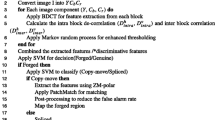Abstract
Internet of Things (IoT) image sensors for surveillance and monitoring, digital cameras, smart phones and social media generate huge volume of digital images every day. Image splicing and copy-move attacks are the most common types of image forgery that can be done very easily using modern photo editing software. Recently, digital forensics has drawn much attention to detect such tampering on images. In this paper, we introduce a novel feature extraction technique, namely Sum of Relevant Inter-Cell Values (SRIV) using which we propose a passive (blind) image forgery detection method based on Discrete Cosine Transformation (DCT) and Local Binary Pattern (LBP). First, the input image is divided into non-overlapping blocks and 2D block DCT is applied to capture the changes of a tampered image in the frequency domain. Then LBP operator is applied to enhance the local changes among the neighbouring DCT coefficients, magnifying the changes in high frequency components resulting from splicing and copy-move attacks. The resulting LBP image is again divided into non-overlapping blocks. Finally, SRIV is applied on the LBP image blocks to extract features which are then fed into a Support Vector Machine (SVM) classifier to identify forged images from authentic ones. Extensive experiment on four well-known benchmark datasets of tampered images reveal the superiority of our method over recent state-of-the-art methods.
Access this chapter
Tax calculation will be finalised at checkout
Purchases are for personal use only
Similar content being viewed by others
References
Meola, A.: The Internet of Things: Meaning & Definition. Business Insider (2018)
Redi, J.A., Taktak, W., Dugelay, J.-L.: Digital image forensics: a booklet for beginners. Multimed. Tools Appl. 51, 133–162 (2011)
Novak, M.: That Viral Photo of Putin and Trump is Totally Fake. gizmodo.com (2017)
Kwitt, R., Meerwald, P., Uhl, A.: Lightweight detection of additive watermarking in the DWT-domain. IEEE Trans. Image Process. 20, 474–484 (2011)
Zhang, Y., Zhao, C., Pi, Y., Li, S., Wang, S.: Image-splicing forgery detection based on local binary patterns of DCT coefficients. Secur. Commun. Netw. 8, 2386–2395 (2015)
Alahmadi, A.A., Hussain, M., Aboalsamh, H.A., Ghulam, M., Bebis, G., Mathkour, H.: Passive detection of image forgery using DCT and local binary pattern. SIViP 11, 81–88 (2017)
Ng, T.-T., Chang, S.-F.: A model for image splicing. In: IEEE International Conference on Image Processing (2004)
Hsu, Y.-F., Chang, S.-F.: Detecting image splicing using geometry invariants and camera characteristics consistency. In: International Conference on Multimedia and Expo, Canada (2006)
Dong, J., Wang, W., Tan, T.: CASIA image tampering detection evaluation database. In: IEEE International Conference on Signal and Information Processing, pp. 422–426 (2013)
Dong, J., Wang, W.: CASIA tampered imaged detection evaluation database (CASIA TIDE v2.0). National Laboratory of Pattern Recognition, Chinese Academy of Science (2009–2016)
Ng, T.-T., Chang, S.-F., Sun, Q.: Blind detection of photomontage using higher order statistics. In: IEEE International Symposium on Circuits and Systems, pp. 688–691 (2004)
Fu, D., Shi, Y.Q., Su, W.: Detection of image splicing based on Hilbert-Huang transform and moments of characteristic functions with wavelet decomposition. In: Shi, Y.Q., Jeon, B. (eds.) IWDW 2006. LNCS, vol. 4283, pp. 177–187. Springer, Heidelberg (2006). https://doi.org/10.1007/11922841_15
Chen, W., Shi, Y.Q., Su, W.: Image splicing detection using 2-D phase congruency and statistical moments of characteristic function. In: Proceedings of SPIE 6505, Security, Steganography, and Watermarking of Multimedia Contents IX, vol. 6505. SPIE, Washington (2007)
Dong, J., Wang, W., Tan, T., Shi, Y.Q.: Run-length and edge statistics based approach for image splicing detection. In: Kim, H.-J., Katzenbeisser, S., Ho, Anthony T.S. (eds.) IWDW 2008. LNCS, vol. 5450, pp. 76–87. Springer, Heidelberg (2009). https://doi.org/10.1007/978-3-642-04438-0_7
He, Z., Sun, W., Lu, W., Lu, H.: Digital image splicing detection based on approximate run length. Pattern Recogn. Lett. 32, 1591–1597 (2011)
Shi, Y.Q., Chen, C., Chen, W.: A natural image model approach to splicing detection. In: Proceedings of the 9th Workshop on Multimedia & Security, pp. 51–62. ACM, USA (2007)
He, Z., Lu, W., Sun, W., Huang, J.: Digital image splicing detection based on Markov features in DCT and DWT domain. Pattern Recogn. 45, 4292–4299 (2012)
Wang, W., Dong, J., Tan, T.: Image tampering detection based on stationary distribution of Markov chain. In: IEEE International Conference on Image Processing, pp. 2101–2104 (2010)
Khayam, S.A.: The discrete cosine transform (DCT): theory and application. Michigan State University (2003)
Chang, C.-C., Lin, C.-J.: LIBSVM: a library for support vector machines. ACM Trans. Intell. Syst. Technol. 2, 27:21–27:27 (2011)
Acknowledgement
This work is supported by the Research Priority Area (RPA) scholarship of Federation University Australia.
Author information
Authors and Affiliations
Corresponding author
Editor information
Editors and Affiliations
Rights and permissions
Copyright information
© 2018 Springer Nature Switzerland AG
About this paper
Cite this paper
Islam, M.M., Kamruzzaman, J., Karmakar, G., Murshed, M., Kahandawa, G. (2018). Passive Detection of Splicing and Copy-Move Attacks in Image Forgery. In: Cheng, L., Leung, A., Ozawa, S. (eds) Neural Information Processing. ICONIP 2018. Lecture Notes in Computer Science(), vol 11304. Springer, Cham. https://doi.org/10.1007/978-3-030-04212-7_49
Download citation
DOI: https://doi.org/10.1007/978-3-030-04212-7_49
Published:
Publisher Name: Springer, Cham
Print ISBN: 978-3-030-04211-0
Online ISBN: 978-3-030-04212-7
eBook Packages: Computer ScienceComputer Science (R0)





